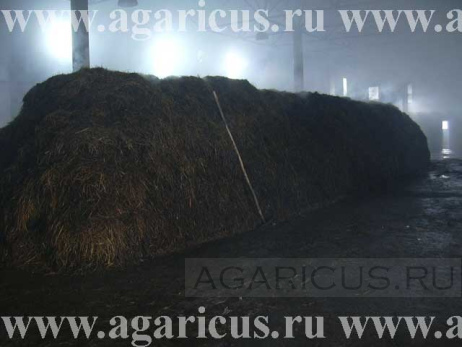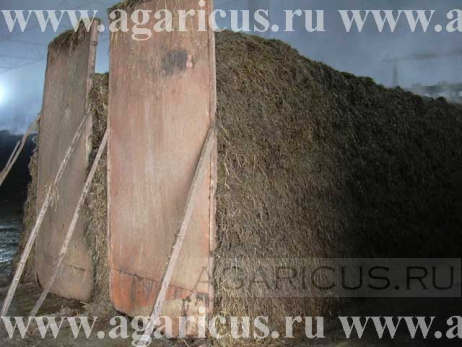Forming a cone (pile)
A compost cone (pile)
In order to understand the importance of laying the compost mass in piles or cones, let’s try to penetrate into the essence of the composting process, even very simplistically. Very schematically, the process looks like this. The first to function are the microorganisms that live under ordinary temperature conditions, the humidification of straw and manure is the signal for them to start functioning. These «living creatures» begin feeding and multiplying, which is why energy in the form of heat is released. Next, it’s up to physics. When the amount of energy released by the microorganisms in the process of their vital activity is higher than the amount of lost energy, the compost’s temperature rises.
Screens used for laying the compost in a cone
The losses are possible when that energy is taken from the compost, in our case it happens when there’s excess air exchange in that mass. In other words, if the inside of compost pile is drafty, this kind of compost will never begin to function. It’s not difficult to guess, that the intensity of air exchange inside the mass of compost will depend on the shape and size of the piles, cones and clamps. In the beginning of the composting process, when the straw’s structure is hard and firm, the dimension of the piles should be much bigger, than in the end of the fermentation process, when the straw’s structure is much softer. This means that composting is an aerobic process which requires the presence of oxygen. Knowing how much, when and where is one of the main conditions of obtaining good compost. If there’s too much oxygen, the composting process simply will not begin, (perhaps because of this, the temperature of the compost pile’s surface doesn’t differ from the surrounding air temperature much), or the temperatures will be not high enough, which will result in great loss of organic matter. When there’s lack of oxygen, anaerobic processes will begin, which will negatively affect the compost’s quality.
The compost production technologist’s goal is to pick the optimal dimensions and shapes of piles, cones and clamps considering the straw’s quality, the compost’s structure, its humidity and the temperature of the air where that compost is made, and of course, the readiness of the compost. It’s important that the biggest volume of the compost pile functioned in an optimum performance. In order to control that, temperature must be measured in different parts of the compost. The most objective indicator is the formation of the «temperature section» of the pile, cone and clamp. All drawbacks at forming the piles, cones and clamps — nonuniform thickness, uneven surface, incorrect form, all this is reflected on the compost’s temperature.



Lko:
Saheb hamare mushroom dry bable se pura form doob chuka hai ismein Ham Kya Karen Sahab Koi upay Ho to...
Production of Compost, Personal opinion (part 3). Wet...Abimbola Olaniyi-Balogun, Lagos Nigeria:
Hello there, I made mushroom compost using the long composting method. I used wet chicken manure, fresh...
Mushrooms in KazahstanZagreb, Croatia:
My name is Zlatko Vidmar.
Without chicken manure compost? Yes, it's possible...I am in modern mushroom growing over 40 years.
I see your farm and if...
nanyuki:
my email is samuelnjogo@gmail.com
Without chicken manure compost? Yes, it's possible...nanyuki:
i want to learn like a child on compost making for mushroom
Mushrooms in KazahstanVELLORE TAMILNADU INDIA:
SUITABLE JOBS – MUSHROOMS GROWER / COMPOST / SPAWN OR RELAVANT FIELDS
Without chicken manure compost? Yes, it's possible...Dear Hiring Manager...
Patna:
PLEASE SEND YOUR FORMULA without-chicken-manure-compost
watering first flush mushroomswasil, Malaysia:
i suggest you not to water on mush just maintain the good humidity if you not have any auto system for...
Compost Production. Personal opinion (Part 2)NARENDER SEHRAWAT, FARIDABAD NCR:
COMMON PROBLEM IN PHASE 1 BUNKAR IS THE UNBALANCED TEMERATURE, IT STARTS FROM 50-55 DEGREES TO 78-82...
Without chicken manure compost? Yes, it's possible...Hannes, Plettenberg Bay, South Africa:
Can you give me more details on compost without chicken manure for mushroom growing, what alternatives...